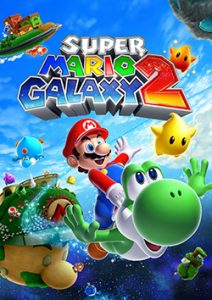1008th played so far
Genre: Platform
Platform: Wii
Year of Release: 2010
Developer: Nintendo EAD Tokyo
Publisher: Nintendo
There are, of course, a lot of platform games on the list. And while there are many big names in the genre, I think it’s indisputable that Mario is the king of the genre. While the original Super Mario Bros. is primitive now, I remember how much of a marvel it was at the time, and Super Mario Bros. 3 and Super Mario World are still pinnacles of the genre. After that Mario starred in many other genre games as well, RPGs and kart racing among the most notable.
But most notable for today is how in 1996 Nintendo released Super Mario 64. While there were some 3D platformers before, Super Mario 64 really made them work. There were some camera issues, but the game defined the movable camera as we still know it today, as mixed as it make work these days. The legacy is still there in Super Mario Odyssey, the most recent 3D Mario platformer, and I hope the spirit is there in the second entry in the Super Mario Galaxy series, the most recent one when the book’s second edition was released.
Platform
It feels like we’re closing off a big genre with platform games. While other bigger and older genres exist, action games are so fluid that they have no identity while there are various different shoot ’em up variants that don’t overlap beyond that you’re shooting things in them. On the other hand, there’s a difference between 2D and 3D platformers, but beyond that there’s a lot they have in common. There have been some experiments with how you jump – something the first didn’t always have and that Bionic Commando changed, but the core gameplay has stayed the same.
And that familiarity with the core has made the genre one where you can do a lot of experimentation, something that’s shown in the list as the early indie boom starts. Braid‘s strength is built on familiarity with the genre, which you can then extrapolate to experiment with further. Even now, there are a lot of experiments in the genre, and even some that aren’t classified as platformers but take after them, like Spelunky, use that DNA and develop it further. It’s never a genre I felt in love with, but it’s one of the first I played (Super Mario Bros. may, indeed, be the first video game I ever played) and I enjoy going back to it, alone or in co-op.
Our Thoughts
I’m glad I played Super Mario Galaxy before this, as Super Mario Galaxy 2 really feels like a sequel. It builds on a lot of the elements of its predecessor, while adding some of its own. The game is quite aware of that, which means that (thankfully) the explanations and tutorials are kept to a minimum. There is enough help if you need it, with some additional modes to help those who really struggle, but if you already know other games in the genre Super Mario Galaxy 2 really allows you to just jump in and get on with it.
All of that comes from a larger amount of gravity-bending puzzles, playing around with the different worlds and world shapes and letting you do a lot more of what the first game did. There is quite a bit of repetition in it – building on the concepts you already know and changing them up slightly – but the innovation is enough to keep you entertained. One of the big additions, the return of Yoshi, sits at the center of the game, with his house being the first area you visit and him being playable quite often. The controls are a bit weird – I suspect it’s mostly me struggling getting used to it, but it wasn’t as intuitive as the game seemed to assume it was.
Yoshi’s appearance also is part of the charms of the game. Your hub isn’t Princess Rosalind’s observatory, but is instead Starship Mario, shaped like Mario’s head and almost fully manned by the lumas, the star-shaped creatures that you encounter throughout the game. All sorts of smaller features start showing up as you unlock more features of the game, including a floating mushroom nearby with the Toad Brigade. It feels like the game adds that bit of personality to the world, stepping up a bit from the first game.
Final Thoughts
Even as it seems like the difficulty ramps up quicker than the first game – there are some devious worlds available a lot sooner than you’d expect – the charm does a lot to carry you through the game. There are so many different worlds to uncover and things to see that it feels like you won’t run out any time soon, and it genuinely holds up in a way few sequels that hew this closely do.
